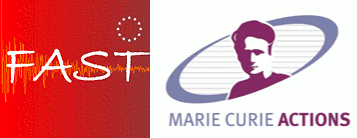These are the projects in reverse chronological order that have funded the development of jMRUI.
INSPiRE-MED project: 2019-2022

The development of the jMRUI software will be funded during the next four years by INSPiRE-MED – Integrating Magnetic Resonance Spectroscopy and Multimodal Imaging for Research and Education in Medicine (Grant agreement ID: 813120), an European Union funded H20H20-MSCA Innovative Training Network, running from 1st January 2019 till 31st December 2022. The project is coordinated by Prof. Dominique Sappey-Marinier of Université Claude Bernard Lyon-1.
ISIB project: 2017-2020
jMRUI development was funded during the period 2017 to 2020 from European Regional Development Fund-Project “Modernization and support of research activities of the national infrastructure for biological and medical imaging Czech-BioImaging” (No. CZ.02.1.01/0.0/0.0/16_013/0001775) at the Institute of Scientific Instruments of the Czech Academy of Sciences.
TRANSACT project: 2013-2017

The development of the jMRUI software during the past years was funded by TRANSACT – Transforming Magnetic Resonance Spectroscopy into a Clinical Tool (PITN-GA-2012-316679), an EU-funded FP7-PEOPLE Marie Curie Initial Training Network running from 1st March 2013 till 28th February 2017. The project was coordinated by Prof. Sabine Van Huffel of Katholieke Universiteit Leuven. One of the project main goals was:
… pursuing research advances in theoretical and practical aspects of MRS, in particular experimental design by quantum mechanical simulation, data acquisition, data processing, data fusion and biomedical applications in oncology and neurology…
and jMRUI was the software platform where all those practical improvements were implemented.
FAST project: 2006-2010

On 2006, our project proposal submitted to the Marie Curie Research Training Network (RTN) call of the 6th Framework Programme, was aproved and funded, resulting in the European project FAST, Advanced Signal-Processing for Ultra-Fast Magnetic Resonance, and Training (MRTN-CT-2006-035801), which lasted from 1st December 2006 up to 30th November 2010. The project was coordinated by Prof. Graveron-Demilly of Université Claude Bernard – LYON 1.
UCBL Projects: 2002-2006
While applying for a new European Research Network project, Dr. Danielle Graveron-Demilly pursued the development of jMRUI with her PhD students and Computer Sciences Engineers at the Université Claude Bernard Lyon 1 (Lyon, France). The development was supported by her own grants from Philips Medical Systems (The Netherlands), the French Centre National de la Recherche Scientifique (2001-2009) and from the Rhône-Alpes region (France).
TMR project: 1998-2001
MRUI development was funded during the period comprised between January 1998 and December 2001 by the European Union project TMR/Networks ERB -FMRX -CT970160 . This project was awarded to groups in Athens, Delft (coordinator), Leipzig, Leuven, Louvain-La-Neuve, Lyon, and Xanthi, and the research groups directly involved in the development of the MRUI software were:
- Dr. Danielle Graveron. CNRS URA-D2057, Université Claude Bernard – LYON 1. Villeurbanne, France.
- Miquel E. Cabañas (as subcontractor of UCBL). SeRMN & BBM, Universitat Autònoma de Barcelona. Cerdanyola del Vallès, Catalunya, Spain.
- Dr. Paul Van Hecke. Dept. Electrical Engineering, ESAT/SISTA, Katholieke Universiteit Leuven. Leuven, Belgium.
- Dr. Sabine Van Huffel. Dept. Electrical Engineering, ESAT/SISTA, Katholieke Universiteit Leuven. Leuven, Belgium.
- Dr. Dirk van Ormondt. Applied Physics Laboratory, Technische Universiteit Delft, Delft, The Netherlands.
- Arend Herschap and Marinette van der Graaf (as subcontractors of D.v.O.). University Hospital of Nijmegen. Nijmegen, The Netherlands.
HCM project: 1994-1997
Starting on 1st October, 1994 and up to 31st March, 1997, MRUI development was funded by the European project Advanced Signal Processing for Medical Magnetic Resonance Imaging and Spectroscopy (HCM-CHRX-CT94-0432) of the Human Capital & Mobility/Networks program. The project was awarded to groups in Athens, Delft (coordinator), Leipzig, Leuven, Louvain-La-Neuve, Lyon, and Xanthi (in alphabetical order). The groups listed below actively participated in the development of the MRUI software (also in alphabetical order):
- Dr. Danielle Graveron. CNRS URA-D2057, Université Claude Bernard – LYON 1. Villeurbanne, France.
- Dr. Paul Van Hecke. Dept. Electrical Engineering, ESAT/SISTA, Katholieke Universiteit Leuven. Leuven, Belgium.
- Dr. Sabine Van Huffel. Dept. Electrical Engineering, ESAT/SISTA, Katholieke Universiteit Leuven. Leuven, Belgium.
- Dr. Dirk van Ormondt. Applied Physics Laboratory, Technische Universiteit Delft. Delft, The Netherlands.
Early days
MRUI development prior to the European projects was funded by, at least (*) the projects listed below. Unfortunately, we do not have a complete list, thus, if you know of any source of fund that should be acknowledged here, please, let us know so that we can give credit to whomever that deserves it.
Cancer Research Campaign, project SP1971/0402. The Ph.D. project of Aad van den Boogaart, titled The Use of Signal Processing Algorithms to Obtain Biochemically Relevant Parameters from Magnetic Resonance Datasets, was part of this project. Aad’s Ph.D. project was supervised by, and the total project funding awarded to, Prof. John R. Griffiths, St. George’s Hospital Medical School, University of London (London, U.K.).
British Council and Spanish Ministry of Education & Science, joint Project HB 94-258. Pattern Recognition and Neural Network Processing of in vivo and in vitro NMR Spectra of Human Brain Tumors for Diagnostic Applications. Awarded to (in alphabetical order),
- Dr. Carles Arús. Dept. of Biochemistry & Molecular Biology, Universitat Autònoma de Barcelona (Cerdanyola del Vallès-Catalunya, Spain).
- Dr. John R. Griffiths The St. George’s Hospital Medical School, University of London (London, U.K.) .
(*) This is not an exhaustive list, i.e. it does not include the financial support for the initial development of MRUI carried out by Ron de Beer at the Laboratory of Spin Imaging, at the Technische Universiteit Delft (The Netherlands).